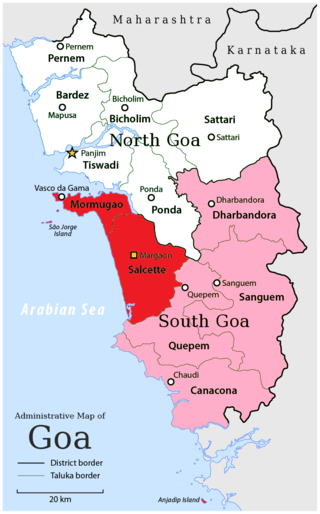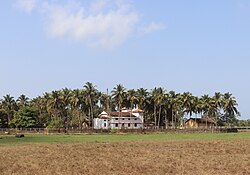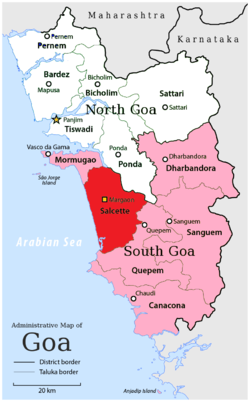
Margao is the commercial capital of the Indian state of Goa. It stands on the banks of the Sal river and is the administrative headquarters of Salcete sub-district and South Goa district. It is Goa's second largest city by population after Vasco.

South Goa district is one of two districts that together constiitue the state of Goa, India, within the region known as the Konkan. It is bounded by North Goa district to the north, the Uttara Kannada district of Karnataka state to the east and south, while the Arabian Sea forms its western coast.
Dom Diogo Rodrigues, Dom Diogo Roiz was a Portuguese explorer of the Indian Ocean who sailed as an ordinary helmsman under the command of Dom Pedro Mascarenhas around Goa. They sailed from the Cape of Good Hope eastward into little-known waters of the newly discovered route to Goa. Rodrigues island was named after him between 4 and 9 February 1528 because he had discovered it during his only return journey from Goa via Cochin to Lisbon, where he was elevated to the rank of a knight (cavaleiro) by John III of Portugal. He then returned to Goa and made a mark in the history of the Portuguese empire in the subcontinent around the mid-16th century.

Benaulim (Bannalem) is a village in the state of Goa, India. Located in Salcete taluka of South Goa district, it neighbours Colva village to the north, Margao in the northeast and Varca village to the south. During Portuguese rule, it was one of the nine communidades in Salcete. Benaulim is the birthplace of St Joseph Vaz, who was a priest and missionary in Sri Lanka. Benaulim is home to several traditional carpenters, and has long been known as Goa's 'village of carpenters'. Contemporary Benaulim is a popular seaside resort, renowned for its beautiful rice fields, balmy weather and golden sand beaches. It also houses Goa's only Don Bosco Animation Centre. There are two big churches in Benaulim. The Holy Trinity Church in Mazilvaddo is a modern church built over the centuries-old chapel of the Loiola Pereira family. The St John the Baptist Church in Povacao area closer to Colva, is where St Joseph Vaz was baptised.

Mormugao is a seaport city situated in the eponymous Mormugao taluka (municipality) of the South district, in the Goa state, India. It has a deep natural harbour and remains Goa's chief port.
Curtorim is a town in the Salcette taluka of South Goa district in Goa, India.It comes under Margao metropolitan region. Curtorim, a verdant agrarian village, known as the "granary of Salcete", is said to have got its name from either kuddtari or kuddtoddi since the agricultural village had kudds (rooms) built on the river bank to store kharif and rabi crops.
Loutolim or LoutulimLottli pronounced:, Portuguese: Loutulim) is a large village of South Goa district in the state of Goa, India. It is an important settlement in the Salcete sub-district.

Mando is a musical form that evolved during the 19th and 20th centuries among the Goan Catholics. It represents a meeting point of local Goan and western musical traditions.

Cortalim is a village in Morumugão, Goa, India. Its native Goan population is entirely Catholic and their main occupations include fishing and agriculture. Located on the banks of the Zuari River, it was previously known as Kushasthale.

The Sal River is a small river in Salcete, Goa, India. Thought to be the smallest river in Goa. The river opens near Verna and flows in south-western direction for 16 kilometers passing through the villages of Nuvem, Mongul, Seraulim, Colva, Margao, Benaulim, Navelim, Varca, Orlim, Carmona, Dramapur, Chinchinim, Assolna, Cavelossim, Mobor and drains itself into the Arabian Sea at Betul. Sal river boating is also a tourist attraction.

Assolna (Osollnnem) is a big village in the Salcete taluka of South Goa district, in the state of Goa, India. It is known for restaurants, ferry, the small traditional market, and local institutions. The Sal river flows through this village.

Colva is a coastal village situated in the Salcete taluka, in South Goa district, of Goa state on the west coast of the Indian subcontinent. Colva Beach spans about 2.5 km (1.6 mi) along a sandy coastline of approximately 25 km (16 mi) extending from Bogmalo in the north to Cabo de Rama in the south.
Raia is a quaint village in the Salcete taluka of South Goa district, Goa state, India. It is located 4 km (2.5 mi) east from the district headquarters of Margao and 35 km (22 mi) from the state capital Panjim.

Quepem is a taluka of South Goa district in the state of Goa, India. It is an administrative region of Goa, India.
Nuvem is a town that is part of the Salcete sub-district of South Goa district, Goa, India.

Rachol is a prominent village in the Salcete taluka (subdistrict) of South Goa district, Goa state, peninsular India. It is located on the left bank of the Zuari River and is home to the famous Rachol Seminary. The famous Portuguese colonial Rachol Fort has been completely erased, leaving behind the traces of the moat and the main gate. The village has many heritage structures and is an important site to study the history of Salcete. The Church of Our Lady of Snows at Rachol is said to be the first church of Salcete and is called the Matriz igreja de Salcette. Ilha de Rachol is a part of the village.

Morumugaotaluka is an administrative subdivision of South Goa district, Goa state, India, headquartered at Mormugao city. It is the state's only subdistrict to have all four modes of transport—air, road, rail, and sea.














